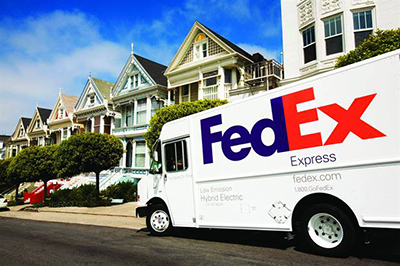FedEx posts gains but falls short of Wall Street expectations for fiscal second quarter earnings
Fiscal second quarter earnings for transportation and logistics bellwether FedEx were a mixed bag, with the company posting revenue gains but falling short of Wall Street expectations.
Quarterly revenue at $14.93 billion was up 16.6 percent annually, operating income at $1.167 billion was up 2.6 percent, and net income at $700 million was up 1.3 percent. Earnings per share at $2.80 were up 7.9 percent annually but did not meet Wall Street expectations of $2.91 per share.
“FedEx increased revenues and operating income despite continued low growth rates in the global economy. We are in the home stretch of our peak shipping season, and our service levels are high, thanks to the outstanding efforts of our hundreds of thousands of team members around the world,” said Frederick W. Smith, FedEx Corp. chairman, president and chief executive officer, in a statement. “The integration of TNT Express into our broad portfolio of global business solutions is proceeding smoothly and according to plan.”
Individual unit quarterly performances: FedEx Express quarterly revenue, excluding integration costs related to its acquisition of TNT Express, were up 2.2 percent annually at $6.74 billion, with operating income up 2.2 percent at $636 million. Operating margin for the segment was flat at 9.4 percent. U.S. domestic revenue per package and U.S. freight revenue per pound were up 3 percent and 6 percent, respectively, with the company citing higher base rates as the driver for the gains. And international export revenue per package saw a 1 percent annual increase, with higher base rates being partially offset by unfavorable currency exchange rates and lower fuel surcharges, while its average daily volume was up 2 percent, due to gains in FedEx International Priority and FedEx International Economy. FedEx attributed gains in operating results to higher base rates and cost efficiencies, including $18 million in TNT Express integration expenses. TNT Express revenue for the quarter was $1.9 billion.
FedEx Ground revenue was up 9 percent at $4.42 billion, but operating income was down 12 percent at $465 billion, with operating margin off 2.5 percent at 10.5 percent. Revenue gains were paced by higher volume and yields, said FedEx, while average daily volume was up 5 percent, due to gains in e-commerce and commercial package increases. And Ground yield, spurred by higher base rates, were up 4 percent.
FedEx Freight revenue was up 3 percent at $1.60 billion, with operating income down 13 percent at $88 million. Average daily shipments were up 3.6 percent annually. Average weight per shipment fell 1.5 percent, which FedEx said offset revenue growth.
With Peak Season in full swing for FedEx, Smith explained on the company’s earnings call that this year will be a “record peak” for the company, adding that to-date, with the exception of several local weather issues, service levels have been outstanding.
“Our traffic mix this year is a bit different by design as part of our longer term commitment to continue to grow earnings, margins, cash flows and returns,” he said. “Christmas falling on a Sunday has created anomalies and shipping patterns, and this week, we will see disproportionately higher demand versus other holiday seasonal patterns in the past.”
On the FedEx Ground side, he noted that results will be affected the Peak Season, with improving margins later this fiscal year versus the current quarter, due to the company opening 4 major hubs and 19 automated stations year-over-year.
T. Michael Glenn, President and Chief Executive Officer, FedEx Services, said on the call that as FedEx closes out another busy Peak Season, which is largely driven by the continued rapid growth of e-commerce, trends continued to evolve, due largely to year-long preparation and collaboration with customers.
“As e-commerce grows, so does the challenge of peak, with multiple days of volume levels approaching or surpassing double our average daily volume,” he explained. “It should be noted that this surge in demand is driven primarily by a relatively small number of customers. Less than 50 large retail and e-tail customers responsible for the majority of peak demand, so it’s extremely important that we understand their forecast well in advance to allow us to plan resources properly.”
Jerry Hempstead, president of Hempstead Consulting, said that the items that shippers need to take away from this earnings announcement is that boxes moving by air went down, while envelope traffic went up, which he said is counter intuitive when thinking about how much information now moves via the Internet.
“In January FedEx announced a 4.9% General Rate Increase (GRI), the impact of which appears to be very muted when evaluating the margin improvement (or lack thereof),” he said. “FedEx has capacity in its air network and it has a lot of new capacity in its ground network (busy now, but Christmas is less than a week away and the volume will reduce dramatically.) That means that if a shipper is using a competitor FedEx may be very interested in your volume when the spring comes and the network is looking to be fed.”
The decline in the domestic air products can be viewed as a cause for concern, he said, under the premise that it was thought the decline was in the past. And he said that air volumes may be viewed as more indicative of the economy in general, as opposed to ground because so much of ground volume is now driven by e-commerce.













